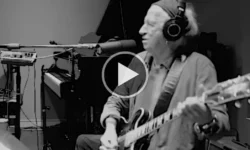MARK KNOPFLER, ERIC CLAPTON, STING & PHIL COLLINS – MONEY FOR NOTHING
A Symphony of Giants: “Money for Nothing”
In the pantheon of rock, few songs capture the zeitgeist of an era quite like “Money for Nothing.” This masterpiece, born from the minds of Mark Knopfler and Sting, and brought to life with the help of Eric Clapton and Phil Collins, stands as a monolith of musical storytelling. The opening riff, a siren call, beckons listeners into a world where dreams and reality collide, wrapped in the gritty glamour of the ’80s rock scene.
With Knopfler’s husky narrative and Sting’s iconic falsetto refrain, the song paints a vivid tableau of ambition and desire. It’s as if each chord strummed on Knopfler’s guitar weaves another layer into the rich tapestry of the song’s narrative, each beat from Collins’ drums a heartbeat driving the story forward. Clapton’s touch, though subtle, is like a ghost in the machine, adding depth and dimension to the sonic landscape.
Echoes of an Electric Dream
At its heart, “Money for Nothing” is a critique wrapped in a paradox, a glittering anthem that questions the very culture it epitomizes. The lyrics, sharp as a knife’s edge, cut through the facade of fame and fortune, exposing the raw underbelly of the music industry. The song’s groove, infectious and relentless, mirrors the relentless pursuit of success, its rhythm a metaphor for the endless cycle of desire and dissatisfaction.
Together, Knopfler, Clapton, Sting, and Collins create a mosaic of sound, each piece a testament to their towering talents. Their collaboration transcends mere performance; it becomes an event, a moment in time where lightning was caught in a bottle.
“Money for Nothing” is not just a song; it’s a journey through the neon-lit nights of a bygone era, a reflection on the price of dreams in the currency of soul and sound. It invites us to listen, to dream, and to question the value of what we yearn for, all while losing ourselves in its unmistakable riff.
We appreciate your time and dedication in reading our article to its conclusion. For more of the finest classic rock music, make sure to follow our Facebook page, “Classic Rock Guitar”. We share exceptional selections every day. Thank you once again for your continued support and readership.



